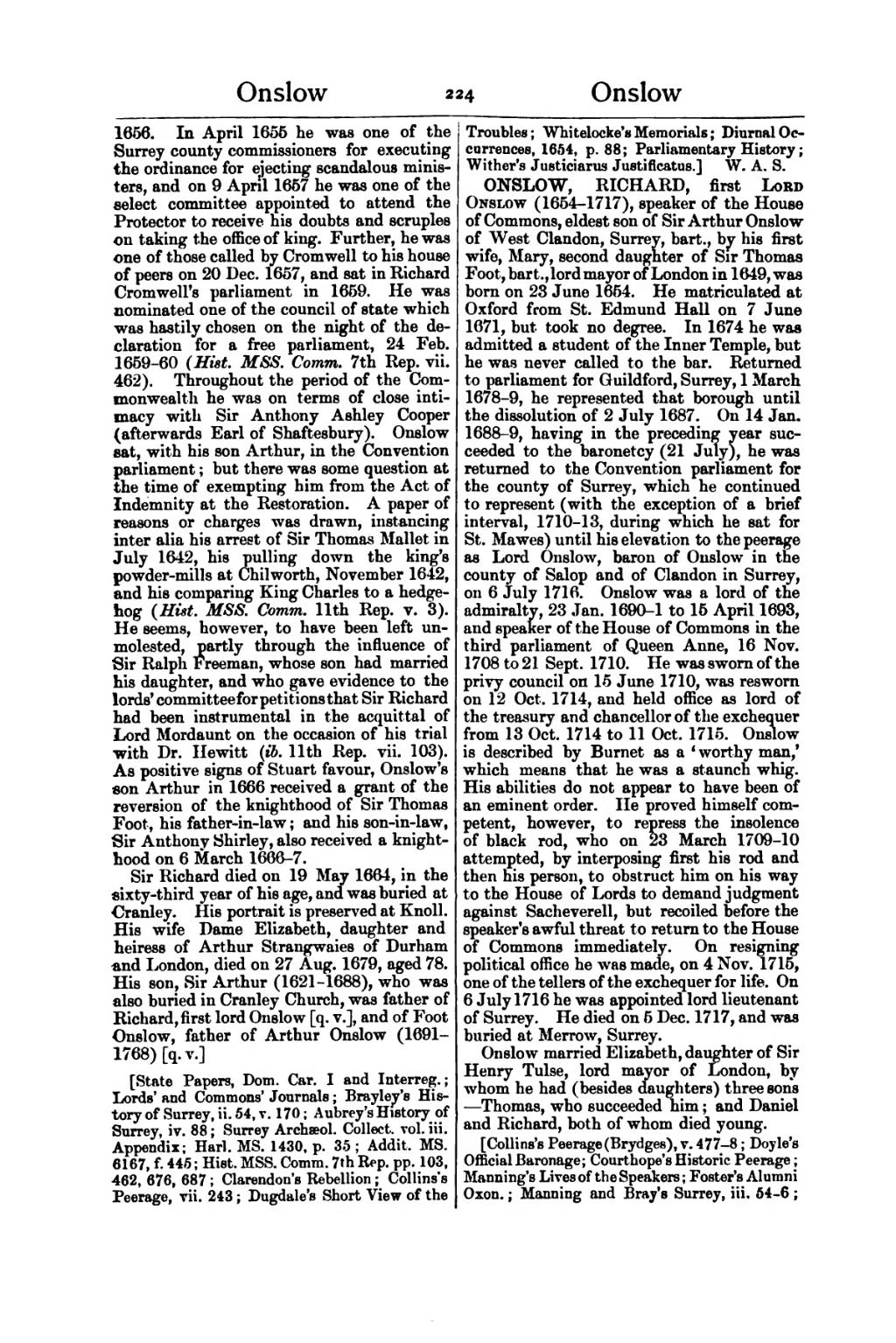1656. In April 1655 he was one of the Surrey county commissioners for executing the ordinance for ejecting scandalous ministers, and on 9 April 1657 he was one of the select committee appointed to attend the Protector to receive his doubts and scruples on taking the office of king. Further, he was one of those called by Cromwell to his house of peers on 20 Dec. 1657, and sat in Richard Cromwell's parliament in 1659. He was nominated one of the council of state which was hastily chosen on the night of the declaration for a free parliament, 24 Feb. 1659–60 (Hist. MSS. Comm. 7th Rep. vii. 462). Throughout the period of the Commonwealth he was on terms of close intimacy with Sir Anthony Ashley Cooper (afterwards Earl of Shaftesbury). Onslow sat, with his son Arthur, in the Convention parliament; but there was some question at the time of exempting him from the Act of Indemnity at the Restoration. A paper of reasons or charges was drawn, instancing inter alia his arrest of Sir Thomas Mallet in July 1642, his pulling down the king's powder-mills at Chilworth, November 1642, and his comparing King Charles to a hedgehog (Hist. MSS. Comm. 11th Rep. v. 3). He seems, however, to have been left unmolested, partly through the influence of Sir Ralph Freeman, whose son had married his daughter, and who gave evidence to the lords' committee for petitions that Sir Richard had been instrumental in the acquittal of Lord Mordaunt on the occasion of his trial with Dr. Hewitt (ib. 11th Rep. vii. 103). As positive signs of Stuart favour, Onslow's son Arthur in 1666 received a grant of the reversion of the knighthood of Sir Thomas Foot, his father-in-law; and his son-in-law, Sir Anthony Shirley, also received a knighthood on 6 March 1666–7.
Sir Richard died on 19 May 1664, in the sixty-third year of his age, and was buried at Cranley. His portrait is preserved at Knoll. His wife Dame Elizabeth, daughter and heiress of Arthur Strangwaies of Durham and London, died on 27 Aug. 1679, aged 78. His son, Sir Arthur (1621–1688), who was also buried in Cranley Church, was father of Richard, first lord Onslow [q. v.], and of Foot Onslow, father of Arthur Onslow (1691–1768) [q. v.]
[State Papers, Dom. Car. I and Interreg.; Lords' and Commons' Journals; Brayley's History of Surrey, ii. 54, v. 170; Aubrey's History of Surrey, iv. 88; Surrey Archæol. Collect. vol. iii. Appendix; Harl. MS. 1430, p. 35; Addit. MS. 6167, f. 445; Hist. MSS. Comm. 7th Rep. pp. 103, 462, 676, 687; Clarendon's Rebellion; Collins's Peerage, vii. 243; Dugdale's Short View of the Troubles; Whitelocke's Memorials; Diurnal Occurrences, 1654, p. 88; Parliamentary History; Wither's Justiciarius Justificatus.]
ONSLOW, RICHARD, first Lord Onslow (1654–1717), speaker of the House of Commons, eldest son of Sir Arthur Onslow of West Clandon, Surrey, bart., by his first wife, Mary, second daughter of Sir Thomas Foot, bart., lord mayor of London in 1649, was born on 23 June 1654. He matriculated at Oxford from St. Edmund Hall on 7 June 1671, but took no degree. In 1674 he was admitted a student of the Inner Temple, but he was never called to the bar. Returned to parliament for Guildford, Surrey, 1 March 1678–9, he represented that borough until the dissolution of 2 July 1687. On 14 Jan. 1688–9, having in the preceding year succeeded to the baronetcy (21 July), he was returned to the Convention parliament for the county of Surrey, which he continued to represent (with the exception of a brief interval, 1710–13, during which he sat for St. Mawes) until his elevation to the peerage as Lord Onslow, baron of Onslow in the county of Salop and of Clandon in Surrey, on 6 July 1716. Onslow was a lord of the admiralty, 23 Jan. 1690–1 to 15 April 1693, and speaker of the House of Commons in the third parliament of Queen Anne, 16 Nov. 1708 to 21 Sept. 1710. He was sworn of the privy council on 15 June 1710, was resworn on 12 Oct. 1714, and held office as lord of the treasury and chancellor of the exchequer from 13 Oct. 1714 to 11 Oct. 1715. Onslow is described by Burnet as a ‘worthy man,’ which means that he was a staunch whig. His abilities do not appear to have been of an eminent order. He proved himself competent, however, to repress the insolence of black rod, who on 23 March 1709–10 attempted, by interposing first his rod and then his person, to obstruct him on his way to the House of Lords to demand judgment against Sacheverell, but recoiled before the speaker's awful threat to return to the House of Commons immediately. On resigning political office he was made, on 4 Nov. 1715, one of the tellers of the exchequer for life. On 6 July 1716 he was appointed lord lieutenant of Surrey. He died on 5 Dec. 1717, and was buried at Merrow, Surrey.
Onslow married Elizabeth, daughter of Sir Henry Tulse, lord mayor of London, by whom he had (besides daughters) three sons—Thomas, who succeeded him; and Daniel and Richard, both of whom died young.
